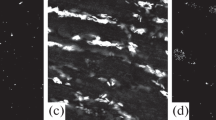Abstract
Using polyclonal and monoclonal antibodies to visualize under a confocal microscope type-1 cannabinoid receptors (CB1) and acetylcholine (ACh) receptors, respectively, or α-bungarotoxin conjugated to Alexa-Fluor 555 for Ach receptors, we found that they colocalize on twitch muscle fibers in the frog (Rana pipiens). We show that both the CB1 and ACh receptors are present on the fast skeletal muscle motor end-plate. The CB1 receptor is present along the entire membrane of the muscle fiber, whereas the ACh receptor is expressed primarily at the motor end-plate. Analysis of the colocalization produced a cross-correlation coefficient of 0.519 ± 0.021 (n = 9) for both receptors at the muscle motor end-plate. This study suggests a close proximity between these two types of receptor proteins and that they could interact. CB1 could function at some stage of excitation–contraction coupling in these muscle fibers. However, further investigation is needed in order to clarify these issues.




Similar content being viewed by others
References
Alworth LC, Harvey SB (2007) IACUC issues associated with amphibian research. ILAR J 48:278–289
Butt SJB, Pitman RS (2002) Modulation by 5-hydroxytryptamine of nicotinic acetylcholine response recorded from an identified cockroach (Periplanetaamericana) motoneuron. Eur J Neurosci 15:429–438
Cavuoto P, McAinch JA, Hatzinkolas G, Janovská A, Game P, Wittert GA (2007) The expresson of receptors for endocannabinoids in human and rodent skeletal muscle. Biochem Biophys Res Commun 364:105–110
Chung SC, Hammarsten P, Josefsson A, Stattin P, Granfors T, Egevad L, Mancini G, Lutz B, Bergh A, Fowler CJ (2009) A high cannabinoid CB1 receptor immunoreactivity is associated with disease severity and outcome in prostate cancer. Eur J Cancer 45:174–182
Gilly WF, Hui CS (1980) Mechanical activation in slow and twitch skeletal muscle fibers of the frog. J Physiol 301:137–156
Hillard CJ, Manna S, Greenberg MJ, DiCamelli R, Ross RA, Stevenson LA, Murphy V, Pertwee RG, Campbell WB (1999) Synthesis and characterization of potent and selective agonists of the neuronal cannabinoid receptor (CB1). J Pharmacol Exp Ther 289:1427–1433
Howlett AC, Barth F, Bonner TI, Cabral G, Casellas P, Devane WA, Felder CC, Herkenham M, Mackie K, Martin BR, Mechoulam R, Pertwee RG (2002) International Union of Pharmacology. XXVII. Classification of cannabinoid receptors. Pharmacol Rev 54:161–202
Huerta M, Muñiz J, Stefani E (1986) The effects of external calcium on potassium contractures in tonic muscle fibers of the frog. J Physiol 376:219–230
Huerta M, Ortiz-Mesina M, Trujillo X, Sánchez-Pastor E, Vásquez C, Castro E, Velasco R, Montoya-Pérez R, Onetti C (2009) Effects of cannabinoids on caffeine contractures in slow and fast skeletal muscle fibers of the frog. J Membr Biol 229:91–99
Institute for Laboratory Animal Research (1996) Guide for the care and use of laboratory animals. Commission on life science, National Research Council, 1996, pp. 1–50
Katina IE, Nasledov GA (2008) A comparative analysis of contracture responses induced by acetylcholine and choline in the twitch and tonic fibers of frog skeletal muscles. Biophysics 53:608–614
Kuffler SW, Vaughan-Williams EM (1953) Properties of the slow skeletal muscles fibers of the frog. J Physiol 121:318–340
Lindgren Clark A, Newman Zachary L, Morford Jamie J, Ryan Steven B, Battani Kathryn A, Su Zheng (2013) Cyclooxygenase-2, prostaglandin E2 glycerol ester and nitric oxide are involved in muscarine-induced presynaptic enhancement at the vertebrate neuromuscular junction. J Physiol 591:4749–4764
McPartland JM, Matias I, DiMarzo V, Glass M (2006) Evolutionary origins of the endocannabinoid system. Gene 370:64–74
Sánchez-Pastor E, Trujillo X, Huerta M, Castro E, Vásquez C, Andrade F (2004) Presence of mRNA for cannabinoid receptor (CB1) in frog and chicken skeletal muscle fibers. Biophysical Society 48th Annual Meeting. Feb. 14–18, 2004, Baltimore, MD. Biophysical Society, Bethesda, MD, p. A2179. http://www.biophysics.org
Sánchez-Pastor E, Trujillo X, Huerta M, Andrade F (2007) Effects of cannabinoids on synaptic transmission in the frog neuromuscular junction. J Pharmacol Exp Ther 321:439–445
Soderstrom K, Leid M, Moore FL, Murria TF (2000) Behavioral, pharmacological, and molecular characterization of an amphibian cannabinoid receptor. J Neurochem 75:413–423
Trujillo X, Sánchez-Pastor E, Andrade F, Huerta M (2014) Effects of cannabinoids on tension induced by acetylcholine and choline in slow skeletal muscle fibers of the frog. J Membr Biol 247:57–62
Wu Y, Zinchuk V, Grossenbacher-Zinchuk O, Stefani E (2012) Critical evaluation of quantitative colocalization analysis in confocal fluorescence microscopy. Interdiscip Sci 4:27–37
Zinchuk V, Wu Y, Grossenbacher-Zinchuk O, Stefani E (2011) Quantifying spatial correlations of fluorescent markers using enhanced background reduction with protein proximity index and correlation coefficient estimations. Nat Protoc 6:1554–1567
Acknowledgments
This work was supported, in part, by a grant from the ConsejoNacional de Ciencia y Tecnología (CONACyT-Mexico, 83113 to MH) and by a grant from Ramón Álvarez-Buylla de Aldana (FRABA to MH and XT). We thank Mr. Ezequiel Viera for his technical assistance.
Conflict of interest
The authors declare no conflicts of interest.
Author information
Authors and Affiliations
Corresponding author
Additional information
Xóchitl Trujillo and Enrique Sánchez-Pastor have contributed equally to this study.
Rights and permissions
About this article
Cite this article
Trujillo, X., Sánchez-Pastor, E., Andrade, F. et al. Presence and Colocalization of Type-1 Cannabinoid Receptors with Acetylcholine Receptors in the Motor End-Plate of Twitch Skeletal Muscle Fibers in the Frog. J Membrane Biol 247, 1199–1205 (2014). https://doi.org/10.1007/s00232-014-9721-5
Received:
Accepted:
Published:
Issue Date:
DOI: https://doi.org/10.1007/s00232-014-9721-5




